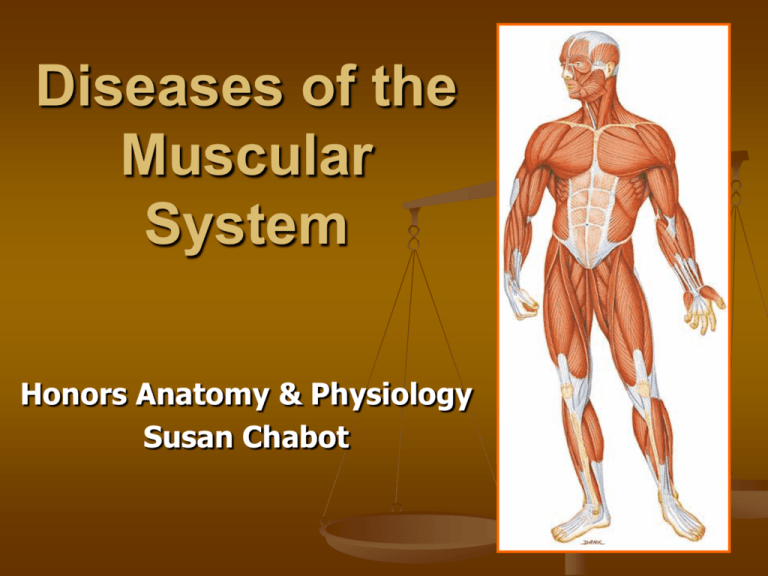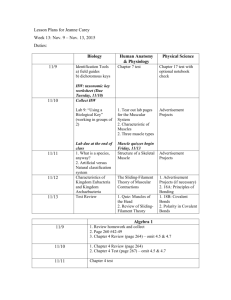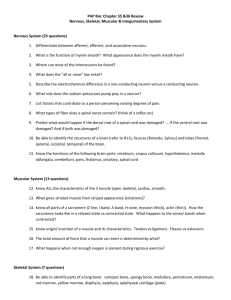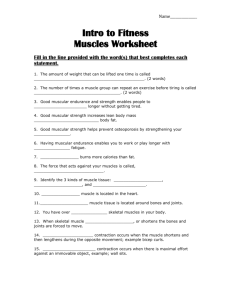Muscle Diseases - Lemon Bay High School
advertisement

Diseases of the Muscular System Honors Anatomy & Physiology Susan Chabot Cause Disease Name Cramps Homeostatic Imbalances Atrophy Torticullis Physical Interruption Spinal cord injury Muscular dystrophy Degenerative Myasthenia gravis Multiple sclerosis Description Characteristic Vocabulary My-/myo-/mys- : prefix meaning of the muscles. -algia : suffix meaning pain. -itis : suffix meaning inflammation. dys- : prefix meaning abnormal. -enia : suffix meaning “disease of”. Category Causes Homeostatic Imbalances Physical/Chemical Interruption Degenerative Diseases Homeostatic Imbalances Characterized by loss of function due to electrolyte imbalance. loss of impulse transmission from nervous system. Can be reversed in many situations. Examples: muscle cramps and “sleeping” appendages. Muscle Cramps Often due to lack of specific electrolytes in interstitial space. Not enough Na+ or Ca+ can result in incomplete muscle contraction. Action potential is lost along sarcolemma (membrane) of muscle fiber. Muscle Atrophy Muscle wasting: muscles lose “bulk” due to inactivity. Several factors can cause muscle atrophy: Casting of injured limb Conscious inactivity Anorexia/malnutrition Paralysis Torticollis AKA cervical dystonia/abnormal cervical (neck) muscle tone. Often occurs due to inactivity during infancy, often with head resting to one side more often than the other. Physical/Chemical Interruption of Muscle Control Traumatic Head injury: will not allow brain to properly transmit directions to muscle to produce voluntary movement. Pinching: of neuro-muscular transmission. Usually reversible with use of anti-inflammatory medications or physical therapy. Spinal Cord injury: next slide Spinal Cord Injuries Interruption of neuro-muscular function due to damage of spinal cord neurons. Level of spinal cord injury determines extent of muscle control interruption. Stem Cell Research: working toward using embryonic stem cells to replace damaged permanent spinal cord cells. Degenerative Diseases Muscular Dystrophy: inherited muscledestroying diseases. Myasthenia gravis: possible autoimmune disorder. Multiple sclerosis: nervous system disorder that affects muscle control. Muscular Dystrophy A group of inherited muscle-destroying diseases that affect specific muscle groups. Muscles enlarge due to fatty deposits, but the muscle fibers atrophy due to degeneration. Several forms are known: Most common and serious form is Duchenne muscular dystrophy. Duschenne Muscular Dystrophy Most common in males. Inherited as a sexlinked recessive disorder. Usually diagnosed between 2 and 6 years of age. Normal children become clumsy and fall as their muscles weaken. Disease begins on extremities and progresses to skeletal muscles necessary for breathing and smooth muscles needed for digestion. Known cause is a genetic defect that inhibits the production of normal sarcolemma protein dystrophin but cure has not yet been found. Inheritance of DMD XY XX X X* X X* XY X* Y This inheritance chart demonstrates the passage of the defective DMD gene from mother to offspring. With a carrier mother, she has the ability to pass on the affected gene to both male and female offspring. Because female children inherit 2 copies of the gene, one from each parent, the “good” X-gene overrides the “bad” X-gene. Male offspring can only inherit 1 X-chromosome, therefore the “bad” copy is expressed. Myasthenia Gravis Antibodies seem to attack ACh receptors, rendering them ineffective. Blood of affected patients contains antibodies to ACh receptors which suggests it is an autoimmune disorder. Progressive muscle disease resulting from loss of ACh function at the neuromuscular junction. Characterized by drooping of eyelids and other facial muscles, difficulty swallowing and talking, and generalized muscle weakness and fatigue. Death usually the result from loss of respiratory function. Multiple Sclerosis Considered an autoimmune disorder; antibodies present that attacks the myelin sheath. Classified as a disease of the nervous system, however affects the function of muscles. Progressive loss of myelin sheath that insulates the dendrites and axons of motor neurons. As demyelination occurs, nerve transmission is slowed or completely lost, resulting in loss of muscle control and function. Typical Motor Neuron Multiple sclerosis results when the myelin sheath surrounding the axons of a motor neuron is stripped away. Dendrites Cell Body Axon Myelin Sheath







